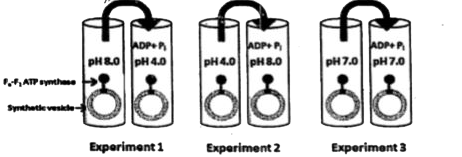ATP synthesis in chloroplast and mithochondria is due to proton gradient across the membrane. Select corrct statement w.r.t formation in chloroplast
(a) Proton accumulates in lumen of thylakiod
(b) Splitting of water occures on inner side of membrane
(c) proton redutase is located on stroma side of chloroplast
(d) NADP reductase is located on stroma side of membrane
Only (a) and (b) are correct
only (b) and © are correct
only ( c) and (d) are correct
(a), (b) and (d) are correct
The correct Answer is:D
Step by step video, text & image solution for ATP synthesis in chloroplast and mithochondria is due to proton gradient across the membrane. Select corrct statement w.r.t formation in chloroplast (a) Proton accumulates in lumen of thylakiod (b) Splitting of water occures on inner side of membrane (c) proton redutase is located on stroma side of chloroplast (d) NADP reductase is located on stroma side of membrane by Biology experts to help you in doubts & scoring excellent marks in Class 12 exams.
Topper's Solved these Questions
- BOOK - AAKASH INSTITUTECHAPTER - PHOTOSYNTHESIS IN HIGHER PLANTS EXERCISE - Assignment(Section C)60videos
PHOTOSYNTHESIS IN HIGHER PLANTS
- BOOK - AAKASH INSTITUTECHAPTER - PHOTOSYNTHESIS IN HIGHER PLANTS EXERCISE - Assignment(section D)10videos
PHOTOSYNTHESIS IN HIGHER PLANTS
- BOOK - AAKASH INSTITUTECHAPTER - PHOTOSYNTHESIS IN HIGHER PLANTS EXERCISE - Assignment(Section A)45videos
PHOTOSYNTHESIS IN HIGHER PLANTS
- BOOK - AAKASH INSTITUTECHAPTER - ORGANISMS AND POPULATIONS EXERCISE - ASSIGNMENT (SECTION-D) (Assertion-Reason Type Questions)15videos
ORGANISMS AND POPULATIONS
- BOOK - AAKASH INSTITUTECHAPTER - PLANT GROWTH AND DEVELOPMENTEXERCISE - ASSIGNMENT (SECTION -D)10videos
PLANT GROWTH AND DEVELOPMENT
Similar Questions
Apoplast is
(A) Present around the vacuole
(B) Located outside the cell membrane
(C) Situated towards the inner side of plasma membrane
(D) Positioned on both the
sides of cell membraneView SolutionApoplast is
(A) Present around the vacuole
(B) Located outside the cell membrane
(C) Situated towards the inner side of plasma membrane
(D) Positioned on both the sides of cell membraneView Solution
Knowledge Check
- Question 1 - Select One
According to the chemiosmotic hypothesis of ATP formation in the chloroplast, which one does not contribute to the development of proton gradient across the thylakoid membrane?
ASplitting of waterBReduction of NADP+ to NADPH+H+CReduction of NAD+ to NADPH+H+DRemoval of H+ from stroma while transporting electron - Question 2 - Select One
The proton gradient created across the thylakoid membrane in chloroplast :
A. Increases pH of lumen
B. Breaks due to movement of protons from lumen to stroma
C. Provides energy to cause a conformational change in CF1 particle
The correct statements is/areAOnly ABBoth B and CCOnly CDOnly B - Question 3 - Select One
Assertion: The NADP reductase enzyme is located on the stroma side of the membrane of thylakoid
Reason: During proton accumulation in lumen there is measurable decrease in pH in the stroma.AIf both assertion and reason are true and the reason 1s the correct explanation of the assertion.BIf both assertion and reason are true but reason is not the correct explanation of the assertion.CIf assertion is true but reason is false.DIf both assertion and reason are false.
Which of the following does not cause the proton gradient, across the membrane ?
(A) Reduction of NADP
(B) Q - cycle
(C) Spitting of water
(D) Movement of electrons in the photosystem,View SolutionDuring light dependent reaction light energy in coverted to chemical potential energy through the process of chemosis in the chloroplasts which of the following statement about this process is false
I the electron carriers of phosphyorylation are located int he thylakoid
II During phosphorylaton the chloroplast stroma becomes more acidic than the interior of thylakoid membrane
III protons diffuce through the protein channels which are ATP synthetase molecules
IV ATP is forme form ADP +Pi ion the stroma side of the thylakoid in the chloroplast
V During phosphorylation water ionizes to from H++2OH− yielding an e− to PSIIView SolutionRead the following four statements (A-D)
(A) Both, photophosphorylation and oxidative phoshorylation involve up hill transport of protons across the membrane
(B) In dicot stems, a new cambium origanets from the cell of pericycle at trhe time of secondary growth
(C ) Stamens in flowers of Gloriosa and Petunia are polyandrous
Symbiotic nitrogen-fixers occur in the free-living state also in soil
How many of the above statements are rightView SolutionExperiments 1, 2 and 3 were conducted wherein synthetic vesicles containing F0−F1 ATP synthasev were prepared and incubated overnight in a tube. Subsequently, the vesicles were transferred to another tube which alsao contained ADP and Pi (inorganic phosphate).

A. A proton gradient across the vesicular membrane will be present in both experiments 1 and 2 at the time of transfer.
B. As a consequence of the proton gradient, ATP will be synthesised in both experiments 1 and 2.
C. ATP will be synthesised in experimants 3 because Fo-F1 ATP synthase has the inherent property to catalyse the synthesis of ATP from ADP and Pi.
D. ATP will be synthesised in experimants 2 because the proton has to flow out of the vesicles through the F0−F1 ATP synthase for ATP synthesis.View SolutionRead the following four statements (A-D)
(A) Both, photophosphorylation and oxidative phoshorylation involve up hill transport of protons across the membrane
(B) In dicot stems, a new cambium origanets from the cell of pericycle at trhe time of secondary growth
(C ) Stamens in flowers of Gloriosa and Petunia are polyandrous
Symbiotic nitrogen-fixers occur in the free-living state also in soil
How many of the above statements are rightView Solution

